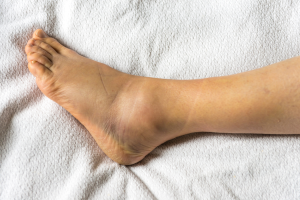 Ankle injuries are among the most common injuries for Americans, impacting millions each year. Unfortunately, far too many of us have asked ourselves the question ‘Did I sprain my ankle or just roll it?’ In fact, it can be difficult to tell the difference between the two injuries, as each can be a significant source of pain and impairment. However, knowing the difference between an ankle roll (twisted ankle) and an ankle sprain can help you decide whether to seek medical attention or not. Additionally, if you think your ankle injury could be more serious, you may want to read our blog post about how to tell the difference between an ankle sprain and a broken ankle.
Ankle injuries are among the most common injuries for Americans, impacting millions each year. Unfortunately, far too many of us have asked ourselves the question ‘Did I sprain my ankle or just roll it?’ In fact, it can be difficult to tell the difference between the two injuries, as each can be a significant source of pain and impairment. However, knowing the difference between an ankle roll (twisted ankle) and an ankle sprain can help you decide whether to seek medical attention or not. Additionally, if you think your ankle injury could be more serious, you may want to read our blog post about how to tell the difference between an ankle sprain and a broken ankle.
In this blog post, we’ll first discuss the common causes of both rolled and sprained ankles. Then, we’ll describe the symptoms you might experience with each injury. After that, we’ll explain what the typical treatments are for both ankle sprains and ankle rolls. Finally, we’ll let you know when it’s time to see a doctor if you’ve experienced one of these injuries.
Common Causes: Rolled Ankle vs. Ankle Sprain
An ankle roll is a common injury that results from the foot being twisted outward or inward. This type of injury is usually caused by slipping, tripping, or during sports. When this happens, the foot will twist outward or inward, stretching the ligaments and tendons in the ankle. This can cause sharp pain and may even cause the person to lose their balance.
An ankle sprain, on the other hand, is a more serious injury. It occurs when ligaments, tendons, and muscles are stretched beyond their normal range of motion. This can happen when the ankle is twisted, overstretched, or even when the foot is stepped on. Often, sprained ankles are caused by a sudden, forceful movement of the ankle, such as running or jumping. A sprained ankle can also be caused by repetitive stress on the ankle joint, such as in running or dancing. It can be very painful and can cause swelling, bruising, and instability in the ankle joint. Ankle sprains also come in a variety of types and grades as opposed to ankle rolls.
Common Symptoms: Ankle Roll vs. Sprained Ankle
The most common symptom of an ankle roll is a pain in the ankle area that may be felt when walking or standing. It may also be accompanied by a popping sound when the ankle is injured. Other symptoms can also include swelling, bruising, and difficulty walking or bearing weight. The ankle may also feel weak or unstable, and the range of motion may be reduced. However, these symptoms usually resolve on their own within a few days with rest and ice. It is important to note, however, that if the pain persists after a few days, you should seek medical attention right away.
 If your symptoms, especially the pain and swelling, are severe and last more than a few days, your injury is likely more serious than an ankle roll. This means you could possibly have a sprained ankle. The most common symptoms of an ankle sprain include severe pain, swelling, bruising, difficulty walking, and instability in the ankle joint. If you experience any of these symptoms, it is important to seek medical attention right away.
If your symptoms, especially the pain and swelling, are severe and last more than a few days, your injury is likely more serious than an ankle roll. This means you could possibly have a sprained ankle. The most common symptoms of an ankle sprain include severe pain, swelling, bruising, difficulty walking, and instability in the ankle joint. If you experience any of these symptoms, it is important to seek medical attention right away.
Typical Treatments: Rolled Ankle vs. Sprained Ankle
The typical treatment for a rolled ankle includes rest, ice, compression, and elevation (RICE). Other treatments may include using a brace or crutches to keep weight off the injured ankle, taking over-the-counter pain medications, and doing physical therapy exercises to help strengthen the ankle muscles and improve the range of motion.
Treatment for a sprained ankle typically includes the same RICE protocol as for a rolled ankle but may involve a longer period of rest and rehabilitation. Depending on the severity of the injury, the ankle may be immobilized in a cast or brace to help the ligaments heal. Physical therapy may also be recommended to help restore strength and range of motion to the ankle. In some cases, surgery may be required to repair any tears in the ligaments.
 When should I see a doctor about my ankle injury?
When should I see a doctor about my ankle injury?
If you experience any of the following symptoms, it’s important to seek medical help right away:
- Severe swelling
- Inability to bear weight on the injured ankle
- Severe pain
- Instability or the feeling that the ankle may “give out”
- Signs of a fracture, such as a visible deformity, popping or grinding sound at the time of injury, or severe bruising
- Numbness in the foot or toes
In Closing
In conclusion, if you’re still not sure if your injury is an ankle sprain or an ankle roll, it’s best to contact a doctor. They will be able to conduct a physical examination and ask questions about the injury. They may also order imaging tests such as X-rays or MRI scans to confirm the diagnosis. With the right diagnosis and treatment, you can get back to your daily activities in no time.

With two locations near Nashville in Mt. Juliet and Hermitage, Advanced Ortho and Spine provides patients with high-quality, personalized care. We also strive to advance orthopaedic excellence. Contact us today to learn more or to schedule your appointment.
Disclaimer: This blog provides general information and discussions about health and related subjects. The information and other content provided in this blog, or in any linked materials, are not intended and should not be construed as medical advice, nor is the information a substitute for professional medical expertise or treatment.If you or any other person has a medical concern, you should consult with your healthcare provider or seek other professional medical treatment. Never disregard professional medical advice or delay in seeking it because of something read on this blog or in any linked materials. If you think you may have a medical emergency, call your doctor or emergency services immediately.
The opinions and views expressed on this blog and website have no relation to those of any academic, hospital, health practice, or other institution.

